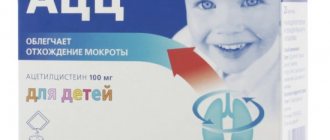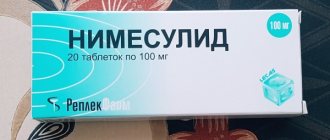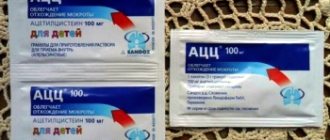Pharmacology
The combination type drug has the following effects:
- antipyretic;
- antihistamine;
- antiviral;
- painkiller.
The medicine is a combination medicine, since it contains several active elements. Therefore, the use of Anvimax refers to complex treatment.
Ascorbic acid has a positive effect on the immune system and triggers natural tissue regeneration processes.
The action of the substance rimantadine is aimed only at the influenza virus type A. It prevents the penetration of harmful microorganisms into the body.
Calcium gluconate is an ion donor. They seep into the vascular walls, which prevents the appearance of increased fragility and permeability of capillaries. This allows you to overcome the source of the inflammatory process during viral diseases and influenza.
Loratadine prevents swelling of virus-infected tissues.
The action of rutoside is aimed at maintaining the integrity of the walls of blood vessels. The active substance makes capillaries less fragile and permeable. It also prevents the appearance of swelling and inflammatory reactions in the affected area.
Paracetamol is well absorbed from the stomach. The maximum concentration is reached 20-30 minutes after administration.
AnviMax, powder for oral solution, lemon, 5 g, 12 pcs.
Paracetamol. Absorption is high. Communication with plasma proteins - 15%. Penetrates the blood-brain barrier. Metabolized in the liver in three main ways: conjugation with glucuronides, conjugation with sulfates, oxidation by microsomal liver enzymes. In the latter case, toxic intermediate metabolites are formed, which are subsequently conjugated with glutathione, and then with cysteine and mercapturic acid. The main isoenzymes of cytochrome P450 for this metabolic pathway are the isoenzyme CYP2E1 (mainly), CYP1A2 and CYP3A4 (minor role). With glutathione deficiency, these metabolites can cause damage and necrosis of hepatocytes. Additional metabolic pathways include hydroxylation to 3-hydroxyparacetamol and methoxylation to 3-methoxy-paracetamol, which are subsequently conjugated to glucuronides or sulfates. In adults, glucuronidation predominates. Conjugated metabolites of paracetamol (glucuronides, sulfates and conjugates with glutathione) have low pharmacological (including toxic) activity. Excreted by the kidneys in the form of metabolites, mainly conjugates, only 3% unchanged. In elderly patients, drug clearance decreases and T1/2 increases.
The maximum concentration (Cmax) of paracetamol in the blood plasma is achieved when using the powder after 0.7±0.39 hours and is 4.79±1.81 mcg/ml, the half-life (T1/2) is 2.73±0.76 h.
Ascorbic acid is absorbed in the gastrointestinal tract (mainly in the jejunum). Communication with plasma proteins - 25%. Diseases of the gastrointestinal tract (peptic ulcer of the stomach and duodenum, constipation or diarrhea, helminthic infestation, giardiasis), consumption of fresh fruit and vegetable juices, alkaline drinking reduce the absorption of ascorbic acid in the intestines. The normal concentration of ascorbic acid in plasma is approximately 10-20 μg/ml. The time of maximum concentration in blood plasma after oral administration is 4 hours. Easily penetrates into leukocytes, platelets, and then into all tissues; the highest concentration is achieved in the glandular organs, leukocytes, liver and lens of the eye; penetrates the placenta. The concentration of ascorbic acid in leukocytes and platelets is higher than in erythrocytes and plasma. In deficiency states, leukocyte concentrations decline later and more slowly and are considered a better measure of deficiency than plasma concentrations. Metabolized primarily in the liver into deoxyascorbic acid and further into oxaloacetic acid and ascorbate-2-sulfate. It is excreted by the kidneys, through the intestines, with sweat, unchanged and in the form of metabolites. Smoking and drinking ethanol accelerate the destruction of ascorbic acid (conversion into inactive metabolites), sharply reducing reserves in the body. Excreted during hemodialysis.
Calcium gluconate. Approximately 1/5-1/3 of orally administered calcium gluconate is absorbed in the small intestine; this process depends on the presence of ergocalciferol, pH, diet and the presence of factors capable of binding calcium ions. The absorption of calcium ions increases with calcium deficiency and the use of a diet with a reduced content of calcium ions. About 20% is excreted by the kidneys, the rest (80%) by the intestines.
Rimantadine. After oral administration, it is almost completely absorbed from the intestines. Absorption is slow. Communication with plasma proteins is about 40%. Volume of distribution - 17-25 l/kg. The concentration in nasal secretions is 50% higher than the plasma concentration. Metabolized in the liver. More than 90% is excreted by the kidneys within 72 hours, mainly in the form of metabolites, 15% unchanged. In chronic renal failure, the half-life increases by 2 times. May accumulate in toxic concentrations in persons with renal impairment and in the elderly unless the dose is adjusted proportionately to the decrease in creatinine clearance. Hemodialysis has little effect on the clearance of rimantadine.
Cmax of rimantadine in blood plasma is achieved when using the powder after 5.28±2.54 hours and is 69.0±19.7 ng/ml, T1/2 - 33.26±12.76 hours.
Rutoside. The time of maximum concentration in blood plasma after oral administration is 1-9 hours. It is excreted mainly with bile and to a lesser extent by the kidneys. T1/2 - 10-25 hours.
Loratadine. Quickly and completely absorbed from the gastrointestinal tract. The maximum concentration in older people increases by 50%. Bonding with plasma proteins is 97%. Metabolized in the liver to form the active metabolite descarboethoxyloratadine with the participation of cytochrome isoenzymes CYP3A4 and, to a lesser extent, CYP2D6. Does not penetrate the blood-brain barrier. Excreted by the kidneys and bile. In patients with chronic renal failure and during hemodialysis, the pharmacokinetics remain virtually unchanged.
Cmax of loratadine in blood plasma is achieved after 3.28±1.25 hours and is 1.85±0.95 ng/ml, T1/2 is 11.29±5.52 hours.
How to use it correctly
Anvimax in any form is intended for internal use.
The product is in powder form. It is necessary to prepare a solution, pour the contents of the package into 100 ml of purified water, stir well. Accept immediately. You can take 1 sachet per day no more than 3 times a day. It is best to drink the medicine after meals. The duration of the treatment course is usually no more than 5 days. The course can be extended only after consultation with a doctor, who will determine the need to continue taking it.
Medicine in capsule form. Take 1 piece no more than 3 times a day after meals. The treatment course is up to 5 days. If the condition does not improve, then you need to make an appointment with a doctor.
Under no circumstances should you self-medicate.
Release form and composition
AnviMax is available in the following forms:
- hard gelatin capsules, size No. 0 (two types): P capsules - blue, contents - a mixture of granules and powder, white or white with a pinkish or creamy tint, sometimes with lumps; capsules P - red, contents - a mixture of granules and powder of white and yellow or yellow with a greenish tint, sometimes with lumps (10 pieces of capsules P in a blister pack and 10 pieces of capsules R in a blister pack, in a cardboard box of one contour blister pack of capsules of different colors);
- powder for preparing a solution for oral administration (raspberry, lemon, cranberry, blackcurrant, lemon with honey): a mixture of granules and powder from almost white to yellow with a greenish tint, having a characteristic odor (depending on the type of powder - raspberry, lemon, cranberry , black currant or lemon with honey), sometimes single pink granules are found; the prepared solution is slightly cloudy, colorless or with a yellowish tint, has a characteristic odor (depending on the type of powder), undissolved yellow particles may be present (5 g in heat-sealable bags, 3, 6, 12 or 24 bags in a cardboard pack).
Composition of 1 capsule P:
- active ingredient: paracetamol – 360 mg;
- auxiliary components: colloidal silicon dioxide, polysorbate 80, lactose monohydrate, pregelatinized starch, magnesium stearate;
- composition of the capsule shell: gelatin, titanium dioxide, brilliant blue dye or proprietary blue dye.
Composition of 1 capsule P:
- active ingredients: ascorbic acid – 300 mg, rimantadine hydrochloride – 50 mg, calcium gluconate monohydrate – 100 mg, loratadine – 3 mg, rutoside – 20 mg;
- auxiliary components: magnesium stearate, potato starch;
- composition of the capsule shell: gelatin, titanium dioxide, crimson dye, yellow iron oxide dye, red iron oxide dye.
Composition of 1 sachet of powder:
- active ingredients: ascorbic acid – 300 mg, paracetamol – 360 mg, rimantadine hydrochloride – 50 mg, calcium gluconate monohydrate – 100 mg, loratadine – 3 mg, rutoside – 20 mg;
- auxiliary components: colloidal silicon dioxide, aspartame, lactose monohydrate, hypromellose, flavoring (depending on the type of powder - raspberry, lemon, cranberry, blackcurrant or lemon with honey).
Contraindications
Anvimax has a fairly large list of contraindications, which you need to familiarize yourself with before taking the medicine:
- increased susceptibility to constituent components;
- diseases of the stomach or intestines;
- lack of fat-soluble vitamin K;
- thyroid pathology;
- pathologies of the kidneys and liver (occurring in acute form);
- chronic alcoholism;
- period of bearing a child and breastfeeding;
- lactose intolerance.
There are certain diseases when, if there are appropriate indications, medicine can be included in conservative treatment, but this should only happen under the supervision of an experienced specialist. These conditions include:
- epilepsy;
- elevated blood sugar levels;
- elderly people;
- thalassemia;
- atherosclerosis.
Drug interactions
AnviMax contains a large number of active components, so you should be aware of its drug interactions with other drugs. This is what the instructions say:
- Paracetamol reduces the effectiveness of uricosuric drugs and increases the effect of anticoagulants.
- The combination of the drug with Phenytoin, Phenylbutazone, barbiturates, tricyclic antidepressants, Rifampicin, hepatotoxic drugs, ethanol leads to the development of severe intoxication.
- Metoclopramide increases the rate of absorption of paracetamol, barbiturates reduce its effectiveness, and microsomal oxidation inhibitors reduce the risk of hepatotoxicity.
- Rimantadine enhances the stimulating effect of caffeine, and cimetidine reduces its clearance by 18%.
- Vitamin C increases the level of benzylpenicillin in the blood.
- The drug improves the absorption of iron preparations in the intestine, increases the excretion of the mineral when combined with Deferoxamine, reduces the effect of antipsychotics, neuroleptics, and phenothiazine derivatives.
- The use of the drug increases the risk of developing crystalluria when combined with salicylates, short-acting sulfonamides, slows down the excretion of acids by the kidneys, and increases the excretion of drugs with an alkaline reaction, including alkaloids.
- AnviMax reduces the blood level of oral contraceptives and sulfonamide drugs.
- Ethanol reduces the concentration of ascorbic acid, the drug increases the clearance of alcohol, reduces the chronotropic effect of Isoprenaline.
- Primidone and barbiturates can enhance the excretion of ascorbic acid.
- The medication reduces the tubular reabsorption of tricyclic antidepressants, insulin and amphetamine.
Adverse reactions
With conservative therapy, undesirable effects may occur:
- from the central nervous system: weakness, drowsiness or agitation, dizziness, headache;
- from the gastrointestinal tract: upset stomach, dry mouth, bloating, lack of appetite;
- from the circulatory system: changes in blood parameters:
- other reactions: allergies in the form of urticaria and skin itching.
Overdose
During the first days after an overdose, pale skin, diarrhea, nausea, stomach pain, vomiting, and impaired glucose metabolism may develop. Complications are tachycardia, metabolic acidosis, arrhythmia, exacerbation of chronic diseases, headache. Severe overdose, according to the instructions, threatens the development of liver failure with progressive encephalopathy, coma, acute renal failure with tubular necrosis.
The overdose threshold is reduced in old age, exhaustion or alcohol abuse. Treatment of overdose consists of the administration of SH-group donors and precursors for the production of glutathione-methionine for 8-9 hours. Further measures are determined by the patient’s well-being and may include the administration of methionine and acetylcysteine. Hemodialysis is effective.
special instructions
The active substance paracetamol may have a negative effect on the liver. Therefore, if there are chronic pathologies of this organ, you should first consult a doctor.
Anvimax does not affect the ability to drive vehicles and other mechanisms, or concentrate on important moments, but it is better to take precautions.
Sold in pharmacies without a doctor's prescription.
Shelf life is 24 months from the date of issue. Store at room temperature in a dry place away from children.
Analogs
The drug can be replaced with drugs with the same therapeutic effect and a similar or different component composition. Drug analogues include:
- Antigrippin - powder and effervescent tablets based on vitamin C, chlorphenamine, paracetamol;
- Brustan - tablets and oral suspension containing paracetamol and ibuprofen;
- Voltaren Acti - tablets, injections, suppositories, patch or spray based on diclofenac;
- GrippoFlu - powder containing paracetamol, phenylephrine, pheniramine, ascorbic acid;
- Coldrex MaxGripp – powder based on paracetamol, ascorbic acid, phenylephrine;
- Nalgesin forte – tablets containing naproxen;
- Tempalgin - tablets based on metamizole sodium, triacetonamine-4-toluenesulfonate;
- Theraflu is a powder containing paracetamol, phenylephrine, pheniramine;
- Fervex is a powder based on paracetamol, pheniramine, vitamin C.
Best before date
All medicines have their own expiration date and Anvimax is no exception. Usually the instructions indicate how long the drug should be stored, and the packaging, blister or bag indicates the date by which the medication can be used. Since Anvimax has several release forms, they have different storage parameters:
| Release form | Time before opening | Time after opening | Storage | Optimal temperature |
| Effervescent tablets | 2 years | — | Dark and dry | Not higher than 25 C |
| Capsules | 2 years | — | Dark and dry | Not higher than 25 C |
| Powder | 2.5 years | apply the powder immediately after opening the sachet | Dark and dry | Not higher than 25 C |
Subject to storage conditions, the drug remains unchanged until the end of the shelf life. If these conditions are violated, the medicine may deteriorate. Unusable medicines acquire the following characteristics:
- Capsules and tablets crumble in your hands and crumble, changing their color.
- The powder may change color, clump, and become lumpy.
5-10 days before the expiration date, the use of medications that have been properly stored and have no signs of spoilage is acceptable.
IMPORTANT : It is not advisable to use a medicine that has expired. It may have no effect or even harm human health.
During pregnancy and breastfeeding
The use of medications is undesirable during pregnancy. In necessary cases, when medications cannot be avoided, doctors choose a course of treatment with drugs that have minimal side effects. Annotations for the drug contain a warning about contraindications for women to take Anvimax when breastfeeding a newborn and during pregnancy.
During early pregnancy
The first weeks are a crucial period in the development of the fetus - the transfer of hereditary information from the parents' chromosomes occurs, the fetus is very vulnerable, so doctors prohibit the use of the drug. After all, the drug affects not only the virus, its active substances are able to penetrate the placenta and have a toxic effect on the fetus.
AnviMax price
The cost of the product is affected by its release form, pack volume, and trade margin. In Moscow, approximate prices will be:
| Type of medicine, release form | Internet price, rubles | Pharmacy price tag, rubles |
| Black currant powder 5 g 12 sachets | 283 | 299 |
| Cranberry powder 5 g 6 sachets | 188 | 199 |
| Lemon powder 5 g 12 packets | 314 | 350 |
| Raspberry powder 5 g 12 sachets | 319 | 350 |
| Capsules 20 pcs. | 224 | 250 |
pharmachologic effect
Due to the presence of six active substances in the drug, the drug has a combined effect, with its help it is possible to carry out complex therapy for viral and colds. Anvimax cold powder has the following pharmacological properties:
- antipyretic;
- painkillers;
- antiviral;
- interferonogenic;
- antihistamine;
- angioprotective.
Indications for use
AnviMax serves as the main pharmaceutical drug that provides etiotropic treatment of influenza type A, that is, the drug provides conservative therapy aimed at eliminating the causative factors in the development of the nosological unit.
As a symptomatic treatment, AnviMax can be used in the following clinical situations:
- colds;
- acute respiratory viral infections;
- pathological conditions, the course of which is accompanied by fever, muscle pain, headache , and chills.










